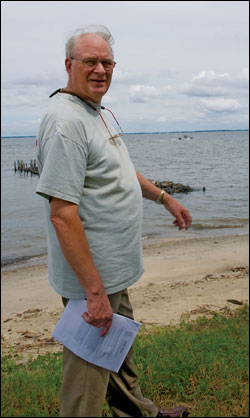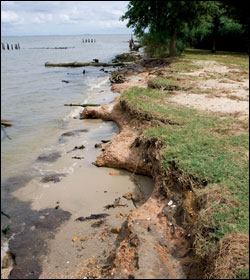|
Sea Change for Bay Beaches
JACK GREER
DARALD LOFGREN, RECENTLY TURNED 70, leans over and points to a shelf of tan-colored clay sticking out from the eroding banks of Mayo Beach. The air is humid. Perspiration dots his gray T-shirt. "Look at that," he says. "All these layers are getting exposed."
Small waves break against a few knuckles of clay that punch out of the crumbling bank, but otherwise it's all white sand here, stretching left and right, a prime stretch of swimmable beach right where the South River meets the Chesapeake. After all the creeks, rivers, and backwaters that have made the Bay so hospitable to human habitation, this strand feels more like ocean.
 |
 |
|
Coming back to serve as manager of Mayo Beach completes a circle for Darald Lofgren (left), who worked the Mayo beaches as a teenage boy. White sands made Mayo Beach a popular destination for decades, but now waves often break against eroding banks and shelves of clay (above). Lofgren has watched the peninsula change, and seen parts of the beach wash away.
Credit: Jack Greer. |
Looking at Lofgren, one can sense the layers. More than a half century ago, when he was 14 and sea level was lower, he worked a summer job here at Mayo Beach. Recently he found an old snow cone machine when he was going through a cluttered closet in one of the park buildings. When he looked at the scribbled list of sugary flavors, he recognized something. His own teenage handwriting. A layer, from long ago.
Now more layers are peeling away as the Bay chews into the shoreline. Sea level rise has eaten into this coastal plain for about 15,000 years, but recently it's been rising faster. And as water licks at the land it uncovers history. Lofgren has found Indian arrowheads here in the shorebreak, and parts of an old millstone. He feels pretty sure that there was a mill here, set by a tidal ditch, now overgrown, that carried water from a large inland pond to and from the Bay. "I told the County [Anne Arundel County] about the millstone," he says, "but so far there's been no interest."
There is a lot of history here at Mayo Beach, once owned by Commodore Isaac Mayo, naval hero of the War of 1812, and according to Lofgren, the man most responsible for locating the U.S. Naval Academy in Annapolis. In so many ways, Mayo Beach is only a shadow of what it once was.
Once Upon a Beach
Perched at the end of the Mayo Peninsula, Mayo Beach Park forms one of the white sand jewels that grace the Bay's Western Shore. Among them, to the north, there's Bay Ridge and Highland Beach. To the south, right next door, Triton Beach and Beverly Beach. And farther down the Bay, Chesapeake Beach. Each beach has its own story, its own rise and fall (see Once Were Bay Beaches).
These small strips of sand, narrowed by eroding waters, once drew large crowds of city-dwellers from Washington, Baltimore, and beyond. Bay Ridge opened in 1880 and by 1895 the local newspaper estimated that 10,000 tourists attended the Fourth of July event there. According to Bay writer Lara Lutz, a large pavilion seated 1,600 diners at Bay Ridge, and the resort eventually covered over 380 landscaped acres.
In 1900, some fifty miles south, Chesapeake Beach opened in Calvert County. The Chesapeake Beach Railroad served the resort, and fliers proclaimed that the seashore was just an hour's train ride away from Washington, D.C. Tourists arrived to find a big wooden boardwalk, arcades, hotels, and a large roller coaster called the Great Derby.
For beaches on the Mayo peninsula, the heyday came a little later. Edgar Kalb opened Beverly Beach in 1925 and bought neighboring Ford Beach (renamed Triton Beach) in 1942. In the late 1930s, Charles Trabing opened Mayo Beach to paying customers. By the 1950s, Mayo, Beverly, and Triton beaches were popular summer destinations. Cars crowded the road that led on and off the peninsula. Locals say they didn't even try to drive on summer weekends.
Some locals didn't complain. The crowds of city-dwellers brought summer work and much-needed dollars. Local boys worked as lifeguards, and one of those boys was Darald Lofgren.
At one time or another, including his student days at the University of Maryland, Lofgren lifeguarded at all three beaches. Now, decades later and after a long career in parks and recreation for Prince George's and Montgomery counties, he's returned to his home waters to serve as manager of Mayo Beach Park, owned by Anne Arundel County since 1976.
The beach is a far cry from the place he knew as a boy, and for eight years, he's watched some of that park slip away.

Bathers by the thousands swarmed to beaches on the Mayo peninsula from the 1920s and 30s right through the 1960s — Mayo Beach, Triton Beach, and Beverly Beach (pictured here). Visiting them now usually requires a reservation.
Credit: The Enoch Pratt Free Library/Arcadia Publishing.
Losing Ground
The biggest change Lofgren noticed when he came back from serving in the Marines in the 1960s, was that the Bay had grown murkier. "You could just see that it looked different," he says.
It's not gotten better. This year the Chesapeake Bay Foundation released Bad Water 2009: The Impact on Human Health in the Chesapeake Bay Region, a report warning that bacterial levels appear to be rising in the Bay, perhaps linked to warming waters and a persistent overabundance of nutrients. Several life-threatening infections in boaters and bathers have raised serious concerns about the safety of swimming in parts of the Bay, especially after a heavy rainfall, according to the report (for a copy of Bad Water 2009, see www.cbf.org).
But the change that most worries Lofgren is quickening sea level rise. With every passing year, he's witnessed how the waves bite farther into the beach. He points to where fishermen could once hop from the shore onto the old stone jetties. Now he says they would have to wade out thirty feet or more to reach them.
"There was a loop road that ran all around the property," he says, pointing toward an eroding shore and an expanding marsh filled with the common reed, Phragmites. "The road used to run outside that tree there, only a couple years ago." The tree now aims its roots toward the clouds. The rest of it lies in the Bay. There's no sign of the road.
At this rate, the place is going to melt away before his eyes.
Like much of the Bay's shoreline, Mayo Beach finds itself between a rock and a hard place. Its appeal lies in its open shoreline — according to Lofgren, the white sand there has always been natural. But if left as is, the beach will likely wash away. A plan by Anne Arundel County to erect large stone revetments and to place piles of rock offshore has raised concerns from environmentalists and drawn fire from local windsurfers worried about losing their launch site. It's a perfect storm of user conflicts. Environmentalists want to see a living shoreline that will preserve natural habitat. The windsurfers want access. And the County wants to keep its park from washing away.
Despite poor communication at the outset of the beach protection plan, the County agreed to meet with the windsurfers to hear their concerns. According to members of the Baltimore Area Boardsailing Association (BABA), the outcome appears to be an acceptable compromise. Contractors will widen the beach area available for launching sailboards and kayaks, and they'll angle a line of pilings to give them more sailing room.
Erik Michelsen, the local riverkeeper who's been fielding complaints, says it seems like a reasonable outcome. "The inescapable truth," he says, "is that the shoreline is migrating."
Of Time and Tide
Lofgren ambles back to the house that serves as his headquarters, an old dwelling encased in later additions. On the floor of a closet lie pieces of millstone he found. Another closet is actually a tight winding staircase, a throwback to old-time architecture.
From his office he can look out over the Bay and remember the past.
The Bay resorts that reigned at the turn of the 20th century lasted only a short time. The train line that delivered tourists to Bay Ridge closed in 1904. The big hotel there burned in 1915. Chesapeake Beach lost the impressive Belvedere Hotel to fire in 1923, and it was not rebuilt. In 1935 the last train left the Chesapeake Beach station bound for Washington.
Change had come to the Bay beaches. A layer of history peeled away.
In 1952, the new Preston Lane Bridge spanned the Chesapeake near Annapolis, and city dwellers extended their drives a bit farther beyond the sea-nettle-plagued Bay to reach the Atlantic. In 1968 Maryland outlawed slot machines, and the gambling pavilions that lined the Bay beaches went silent.
As the 1960s came to a close, civil rights also came to the region, changing the complexion of the Bay's beaches (see A New Day on the Bay).
The landscape changed as well.

White sands along the Mayo peninsula shrink between relentless waves and spreading stands of common reed. Even this thin ribbon of beach draws a woman and her dog on a warm summer day.
Credit: Jack Greer. |
Property surrounding the beaches began to sprout new houses, often as part of a beach owner's larger business plan. Faster automobiles and better roads meant more commuters could work in or near the big cities and still drive home to be by the Bay. More accessible air travel and growing affluence meant that many vacationers could go to the beach in Florida, the Caribbean, or Hawaii.
The Bay's shoreline entered a new era of mixed blessings. It gained big houses, countless cars, cell phones, and jet skis. It lost its clear waters, its underwater grasses, its sprawling oyster bars, and so much of its sandy shoreline. Washed beneath the tides of time are the old beaches where big city tourists once flocked to escape the heat, and where a local boy might make a buck, mixing up snow cones or lifeguarding for all those sunburned city folk.
|

